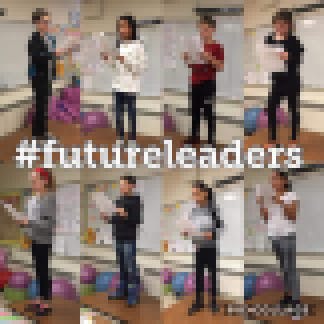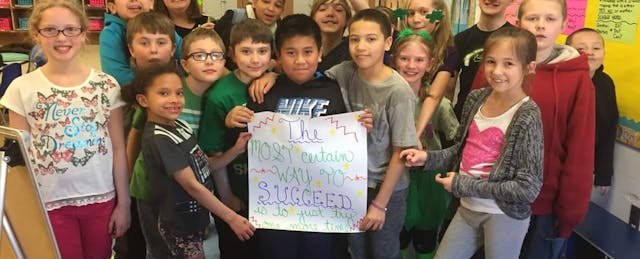When you enter Parker-Varney Elementary School, you are immediately struck by the relaxed atmosphere. Make your way to the office to check in, and you’ll see students walking by and waving, moving in and out of community spaces with confidence and ease. There'll be a buzz of excitement in the air, the mark of students highly engaged and doing work that is important and relevant to their lives.
It wasn’t always this way. Four years ago, in 2013, Parker-Varney was listed as a “School in Need of Improvement.” The school had seen five principals in six years and achievement scores, morale and attendance were sinking. Local families were struggling economically, with 72 percent of students qualifying for Free and Reduced Lunch, and across the district, we were battling an opioid crisis (a problem that continues today, with six parental overdoses at Parker-Varney this year alone).
Rather than crumble, however, we chose to embrace change and focus on what mattered most: whole child development. We honored student needs with multi-age classrooms and competency-based projects. As principal, I encouraged the staff to take risks and to rekindle their passion for teaching and learning. Teachers identified problems of practice and prototyped solutions, and focused on what could be done rather than what couldn’t.

At Parker-Varney, we have a saying: “Learning can be messy, and we must work through the mess.” Today, although the walls of the building are the same, the “spirit” and sense of collaboration have transformed.
Here are a few key ingredients to our success.
Multi-age grade bands
One of the most powerful examples of Parker-Varney’s capacity to change are our multi-age grade bands. They started with a couple of teacher volunteers willing to pilot this model, which required a reconfiguration of the school structure. Despite the struggle, almost the entire staff wanted to pilot either a full or partial implementation (great teachers, right?).
Parker-Varney grade bands—K/1, 2/3, 4/5—allow teachers to gather and review data and respond to academic and social needs more effectively. Moreover, the multi-age model has allowed us to put at least three teachers or staff in every student’s “life boat” since students track with these adults for multiple years during their time at the school. For students experiencing toxic stress from poverty, parental incarceration, homelessness, parental substance abuse, death and neglect, these relationships and support are essential to educating the “whole child.”
Multi-age classrooms also help boost students academic performance. Our second grade students in our 2/3 Band went from 29% proficient in September 2016 to 77% proficient in June 2017 on i-Ready reading assessments. Our English Language Learners went from 54% proficient in September 2016 to 85% proficient in June 2017. We have also seen a decrease in Special Education referrals by 20%.

Project-based learning
Project-based learning is also key to our success. This model supports deep learning over extended periods of time and focuses on solving problems that impact real issues and concerns in students’ lives. As teachers meet and plan project goals with students, they become partners in learning.

In the 2014-2015 school year, our third-graders wanted to improve school lunch. What started as a discussion about healthy options developed into an elaborate project. Students created a survey to send out to all Manchester, N.H. students in second to fifth grades. They then analyzed over 2,500 surveys and began to research options, looking at model programs in the United States and exemplars from Finland. Student representatives went to the Board of School Committee to present their results and give their suggestions. The board was so impressed they issued a RFP for an onsite kitchen at Parker-Varney. The Rockin' Panther Cafe opened in 2016 and students and staff have been enjoying the daily fresh options ever since.
Project-based learning has significantly increased direct instruct time for students. Students who are on or below reading are receiving two to three interventions daily. Perhaps more significantly, by allowing students to choose projects important to them, we are empowering them. Students feel great pride and ownership over their learning when treated with respect, and expectations for both teachers and students rise.
Above all else, great teachers
Ultimately, projects like the Panther Cafe would not have come to pass without the culture we worked hard to create. Across Parker-Varney Elementary, teachers focus on what can work rather than on what is not working. Teachers understand the barriers they face, but choose to make small changes in their instructional practices where possible. These small changes lead to larger, more sustainable change.
If you visit Parker-Varney today, you can observe teachers creating engaging project-based learning plans and elaborate performance tasks. They bring their creations to their peers in a calibration/feedback group before or after school. They give one another critical feedback and celebrate the successes along the way. This process is a 100% teacher-driven initiative in response to them wanting to deepen their learning and understanding of rigorous assessment.
Looking ahead
Today, the school is a safe haven where students can get their needs met, feel safe, and experience success. Our staff can assist in strengthening the home environment through community partnerships, collaboration, home visits and a social worker. These home visits have allowed us to develop deeper relationships with the families and supports for our students after school hours.

These experiences message to our students and staff at Parker Varney that they are not only competent but innovative learners and educators working collectively towards life long success. Our journey is not complete. Much work remains in our quest to provide the best quality education for all students. But our progress in undeniable. Our next steps will be the elimination of traditional grade levels and moving towards student-led performance tasks. Ultimately, our success is no mystery: it’s the work of hard working teachers, engaged students, parental engagement and community support.


